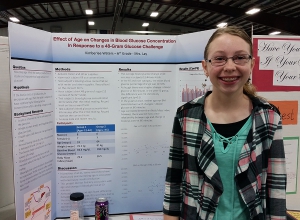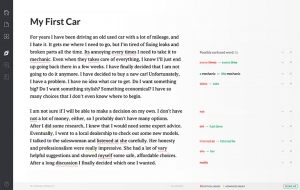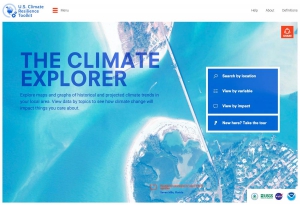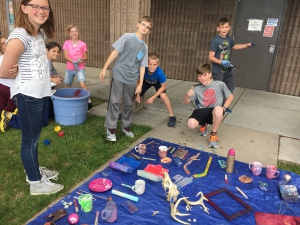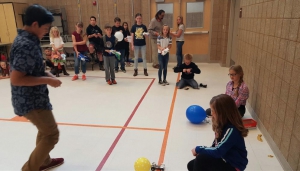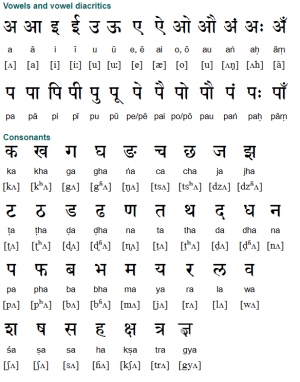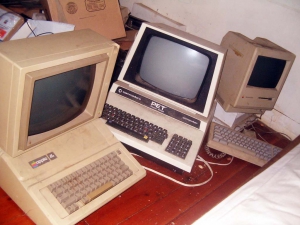Super User
Kanesville Elementary 6th grade student performed well at the district and regional science fairs
Kimberlee, a 6th grade student at Kanesville Elementary, had amazing achievements at this year’s science fairs. She won first place at the school science fair, and then won first place in Chemistry at the district science fair. She also won a Broadcom Master’s Award at the district fair. Kimberlee also attended the regional Ritchey Science and Engineering Fair, and won first place in Chemistry there as well! Her project was titled "Blood Glucose Challenge." She tested several people of different ages to see if age had an effect on how quickly sugar is metabolized. She did this by having people drink a sugar-filled soda, and then tested their blood sugar at regular intervals for the next hour. Kimberlee was even able to tell someone to go to the doctor, where they were diagnosed with diabetes, based on this project! She is amazing!
Grammarly
Climate Explorer
Explore maps and graphs of historical and projected climate trends in your local area. View data by topics to see how climate change will impact things you care about.
This Day in History
Country View 5th graders experiment with hydro-dipping and physical changes
West Haven students participate in balloon car tryouts for the Math and Science Olympiad
Information about the SafeUT app in Weber School District
We recently posted information/resources regarding suicide prevention and warned about the risks to teens associated with the Netfilx series "13 Reasons Why." One particular suicide prevention resource we are promoting/utilizing in our district is the SafeUT app, and information about this important resource was included in that recent post. Several parents have asked questions or expressed concerns concerning the SafeUT app and we’d like to provide additional information to help you glean a better understanding of the merits and limitations of this suicide prevention resource.
View our original article on suicide prevention
SafeUT App Basic Information:
Those utilizing the SafeUT app may contact a crisis counselor any time, day or night, either by text or call. This crisis worker is affiliated with UNI – University Neuropsychiatric Institute/U of U Health – and we are not privy to the number of conversations our students have initiated with a UNI crisis worker. This information is protected by HIPAA – federal legislation which provides data privacy and security provisions for safeguarding medical information. The SafeUT app may also be used to submit an "anonymous" tip to school officials via text messaging. The identity of the originator of the tip is safeguarded, as well – unless he/she identifies himself/herself to school officials in the tip’s text narrative. We strongly encourage every student and parent in Weber School District to download the free SafeUT app!
SafeUT App Statistical Data for WSD:
As of May 1st, 2017, 407 anonymous "tips" have been submitted to school officials via the SafeUT app in Weber School District. When submitting a tip, the following descriptors can be used/selected: abuse, alcohol, bullying, crime, crisis, cutting, cyber-bullying, drugs, fighting, gangs, mental health, planned school attack, school complaint, sexting, sexual misconduct, smoking/tobacco, stealing, suicide, violence, weapons, or "other." Of the 407 anonymous tips submitted, the "top 3" in terms of frequency: 98 tips are labeled "bullying" or "cyber-bullying," 75 tips - "suicide," and 61 tips - "drugs/alcohol/smoking-tobacco." Overall, 75/407 tips, or almost 20% of our tips, relate to suicide. That’s 1 in 5. Alarming! And, it is also a positive, in that it shows our students are reaching out to adults in our schools when in crisis. The SafeUT app has literally saved lives in our schools! The next three most frequent text tips relate to "other," "cutting" and "mental health."
Who responds to tips submitted by students?
UNI screens all text tips submitted by students/parents/patrons in our district. Mental health experts screen those tips and forward them to respective school designees and/or coordinate with local law enforcement agencies if it is a high level crisis situation (threat of violence made to the school, suicidal individual, etc.). Each school has designated at least one administrator to coordinate efforts in the school to respond to that school’s SafeUT tips. In most of our secondary schools, the entire administrative team and at least one counselor screen tips and determine how best to respond. At the district level, several district officials and each of our student services coordinators (each assigned to a "cone" or grouping of schools) receive all tips submitted and coordinate with school administrators to ensure that tips are responded to in a timely/effective manner. Those tips outlining possible student harm are given the highest priority.
What do I do if I feel a tip is not responded to in a timely/effective manner?
If students/parents perceive that a tip has not been "followed through" on, we’d recommend contacting school officials and/or providing more detailed information about the concern in the tip’s narrative. Sometimes, a tip is submitted and no associated students are identified by name, or pertinent information is not included. This makes it very difficult to follow through and resolve the alleged issues outlined in the tip. Also, in most instances, especially those involving multiple students, information regarding how the situation was handled at the school level, student-by-student, cannot legally be shared due to FERPA (Family Education Rights and Privacy Act) restrictions. We strongly advocate to students and parents that if a tip is submitted to school officials in regard to bullying/cyber-bulling and the bullying behavior continues, a follow-up tip should be submitted or school officials contacted with concerns.
If you have further questions about the SafeUT app, please feel free to call the Weber School District Student Services office – 801-476-7811 or 801-476-7817. Parents, thank you for sharing your wonderful kids with us! We want each child in our district to feel supported and valued!
Nepali: A Beginner's Primer Conversation and Grammar
Nepali is an Indo-Aryan language with around 17 million speakers in Nepal, Bhutan, Burma and India. Nepali was originally known as Khas Kurā and was the language of the Khasa kingdom, which ruled over the foothills of what is now Nepal during the 13th and 14th centuries. This site contains some resources from Cornell University for learning Nepali, including audio and text of original dialogs written and recorded by Cornell's language instructors, interlinear transcripts and translations, grammatical explanations, a bi-directional glossary with audio pronunciation, and supplementary videos scripted and produced in Nepal.
How Things Fly
What makes an airplane fly? How does a spacecraft stay in orbit? Why does a balloon float in the air? The Smithsonian National Air and Space Museum explains how with this useful site filled with instructional videos and educational material.
Museum of Old Computers
Early personal computers were nothing like present day computers. They had personality! Each was different and more exciting than the previous, with new features and capabilities. This web site is dedicated to the preservation and display of these vintage computer systems.
